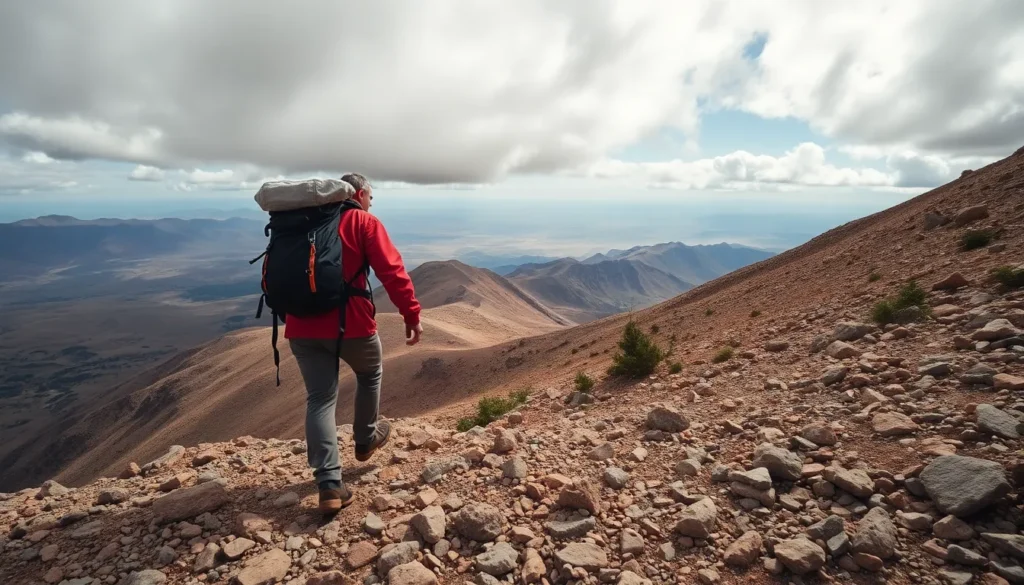Table of Contents
ToggleClimbing Timgoraho Mountain isn’t just a walk in the park—it’s more like a walk in a park that’s been transformed into a rugged obstacle course. With its steep inclines and unpredictable weather, this majestic peak challenges even the most seasoned adventurers. If you’ve ever thought about scaling its heights, you might want to buckle up and prepare for a wild ride.
But don’t let the daunting reputation scare you away! With the right mindset and a dash of humor, conquering Timgoraho can become an unforgettable experience. From breathtaking views to the occasional slip and slide, every step offers a story waiting to be told. So, how hard is it really to climb Timgoraho Mountain? Let’s dive into the nitty-gritty and see if this adventure is worth the sweat—and maybe a few laughs along the way.
Overview of Timgoraho Mountain
Timgoraho Mountain presents a substantial challenge for climbers. Located in Morocco, its elevation reaches 3,466 meters, making it one of the highest peaks in the region. The mountain features rugged terrain, characterized by steep inclines and rocky paths. Climbers often encounter unpredictable weather conditions, complicating the ascent.
As trekkers navigate the mountain’s trails, they experience varying levels of difficulty. Trails range from moderate to strenuous, requiring different levels of fitness and endurance. Many climbers recommend proper preparation, including physical training and gear selection, to enhance safety and enjoyment.
An important aspect of climbing Timgoraho Mountain is the breathtaking scenery. Panoramic views reward those who reach the summit, offering spectacular vistas of the surrounding valleys and peaks. The journey often becomes a memorable experience, filled with opportunities to capture stunning photographs.
Local wildlife adds to the mountain’s appeal. Climbers might spot endemic species or unique flora along the trails. Engaging with the natural environment enriches the adventure, providing a deeper connection to the mountain’s ecosystem.
Ultimately, the climb to Timgoraho Mountain demands respect and preparation. It’s essential to assess personal fitness and experience before attempting the ascent. With the right mindset, climbers can transform challenges into unforgettable memories.
Factors Affecting Climbing Difficulty

Climbing Timgoraho Mountain involves various factors impacting difficulty. Understanding these elements helps climbers prepare effectively.
Terrain and Trail Conditions
Terrain features diverse challenges. Steep inclines require physical strength and endurance. Varying trail conditions may include rocky paths and loose gravel, affecting grip and stability. Sections can vary from moderate to strenuous, thus careful navigation remains essential. Climbers should expect elevation changes that demand attention to foot placement. Proper footwear enhances traction and safety. Additionally, unfamiliar trails increase the challenge, reinforcing the need for knowledge and preparation.
Weather and Seasonal Changes
Weather conditions play a critical role. Climbers might face unpredictable weather patterns, including sudden storms or heavy winds. Seasons greatly affect the experience; winter months may bring snow and ice, while summer can lead to extreme heat. Spring and fall provide milder temperatures, making climbs more enjoyable. Monitoring forecasts before the journey remains crucial. Climbers must adapt to changing conditions and prepare appropriately, as weather significantly impacts safety and overall climbing experience.
Physical Requirements for Climbing
Climbing Timgoraho Mountain demands specific physical attributes and adequate gear for a successful ascent. Fitness preparation plays a crucial role in ensuring climbers can handle the challenges ahead.
Fitness Levels and Training
Physical fitness varies among climbers, though a baseline level is essential for tackling the mountain’s steep terrain. Cardiovascular endurance supports stamina during long hikes, while strength training enhances balance and stability on rocky paths. Engaging in regular aerobic activities, such as running or cycling, builds endurance. Incorporating strength exercises, like squats and lunges, prepares muscles for the rigorous demands. A focused training regimen lasting several weeks or months improves overall fitness, helping climbers confidently navigate Timgoraho’s challenges.
Gear and Equipment Needed
Proper gear ensures safety and comfort throughout the climb. Sturdy hiking boots provide grip and support on uneven surfaces. Lightweight clothing made from moisture-wicking materials helps regulate temperature and adds comfort. A reliable backpack with hydration systems carries essential supplies, including food and safety gear. Navigational tools, such as maps and compasses, guide climbers through varying trails. Lastly, safety equipment like first-aid kits and headlamps for low-light conditions further enhances preparedness for the unpredictable environment on Timgoraho Mountain.
Climbing Experience and Skills
Climbing Timgoraho Mountain requires a mix of experience and skill. Understanding the difference in capability between beginners and experienced climbers plays a crucial role in preparing for the ascent.
Beginner vs. Experienced Climbers
Novice climbers may find Timgoraho challenging due to its steep inclines and variable terrain. Starting with moderate trails offers a gradual introduction to climbing skills. Mentoring from experienced climbers provides valuable insights. Experienced climbers can navigate the rugged paths confidently, adapting to changes in trail conditions and weather. Their training often focuses on endurance and technical skills, making it easier to tackle the mountain’s challenges. For both groups, proper preparation is essential for a successful and enjoyable experience.
Safety Considerations
Safety remains a top priority for all climbers on Timgoraho Mountain. Proper gear significantly reduces injury risks, enhancing overall climbing experiences. Appropriate hiking boots offer essential support and grip on rocky trails. Moreover, climbers should carry navigation tools to avoid getting lost in dense fog or sudden weather changes. Assessing the weather forecast before starting the climb helps avoid dangerous conditions. Carrying first-aid kits provides peace of mind in case of minor injuries. Ultimately, maintaining situational awareness and respecting the mountain contributes to a safe climbing experience.
Climbing Timgoraho Mountain presents a unique blend of challenges and rewards. The rugged terrain and unpredictable weather demand respect and preparation from all climbers. While the ascent can be daunting for beginners the breathtaking views and rich experiences make it worthwhile.
With the right mindset and adequate training anyone can conquer this majestic peak. It’s essential to assess personal fitness levels and gear up appropriately before embarking on this adventure. Ultimately Timgoraho Mountain offers an unforgettable journey for those ready to embrace its challenges.






